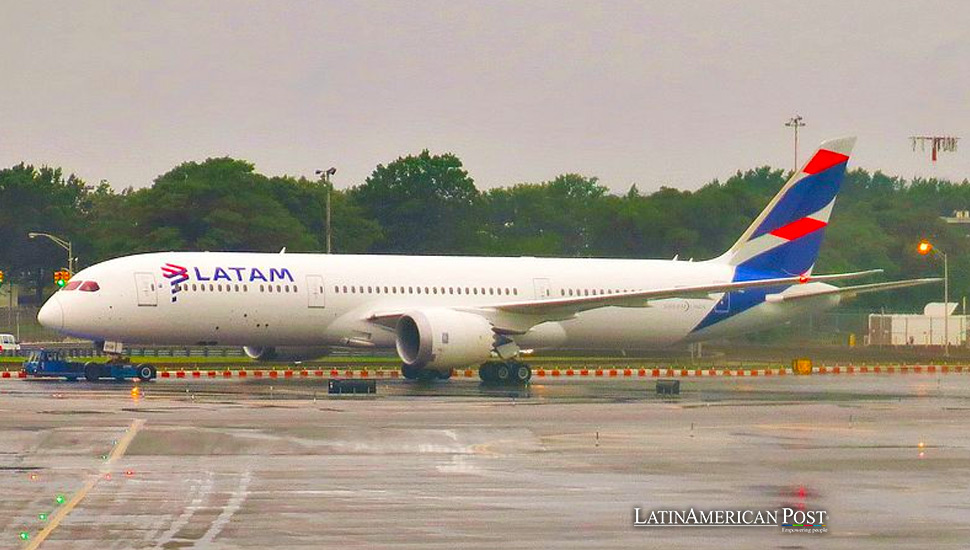Chile’s LATAM Incident Spotlights Boeing’s Turbulence to Regain Trust

Amidst the chaos of a Chilean-based LATAM Airlines flight, Boeing’s turbulent history resurfaces. A routine journey turned midair ordeal underscores the aviation giant’s struggle to regain trust post-737 MAX crises, raising questions for Latin America’s aviation sector.
In-Flight Chaos: Unforeseen Terrifying Ordeal
The harrowing accounts of passengers aboard the Chilean-based LATAM Airlines flight from Sydney to Auckland paint a disturbing picture. What began as a routine journey turned into a terrifying midair ordeal, with people being tossed around the cabin and suffering injuries amidst what the airline vaguely describes as a “technical event.” This isn’t just a human-interest story of a frightening flight; it spotlights an ongoing struggle for aviation giant Boeing to restore its reputation in the face of growing safety concerns.
LATAM’s Boeing 787 Dreamliner, a flagship of modern air travel, became the setting for a scene of chaos. Passengers strapped in and likely relaxing into the long haul were jolted violently as the plane suddenly plummeted. The force was enough to send people flying upward – a sight chillingly evokes horror movie imagery rather than commercial air travel.
While turbulence is always a factor in such incidents, the reported loss of cockpit instrumentation hints at a deeper, potentially systemic flaw within the Boeing aircraft. This isn’t the first time in recent history that a technical issue has turned a Boeing flight into a midair crisis. The lingering shadow of the two fatal 737 MAX crashes casts a long shadow, with many wondering if those tragedies were just the tip of the iceberg for the embattled manufacturer.
The Legacy of Cost Over Safety
The roots of Boeing’s safety woes are complex, and some experts trace the beginning of its declining reputation back to the 1997 merger with McDonnell Douglas. This merger shifted the company’s focus from its engineering-driven legacy towards a more profit-oriented model. Critics argue this shift prioritized cost-cutting and meeting deadlines over the rigorous safety and quality standards that once defined Boeing.
The 737 MAX disaster, in which faulty software and inadequate pilot training led to two fatal crashes, irrevocably tarnished Boeing’s image. Since then, production problems and safety incidents have plagued other Boeing models. Misdrilled holes, faulty rudder components, and the unsettling Alaska Airlines door blowout in 2023 further solidify the image of a company struggling to regain its engineering prowess and where safety concerns overshadow its accomplishments.
The LATAM incident, whether ultimately attributed to a specific technical malfunction or a combination of factors, adds another entry to Boeing’s growing list of recent woes. The entire cause may take months to determine as teams from Chile and New Zealand delve into the black box data, but the damage to public perception of Boeing happens instantly.
This incident raises uncomfortable questions for LATAM Airlines, one of Latin America’s largest carriers, despite the airline’s exemplary safety record. The airline industry is built on trust, and when a major manufacturer like Boeing becomes synonymous with safety concerns, it casts a shadow over all who fly their planes.
While LATAM may not be directly responsible, their passengers’ harrowing experience could shake confidence in the reliability of an airline heavily dependent on Boeing aircraft. It puts the airline in a difficult position, balancing maintaining public trust with the realities of depending on a supplier going through an extended rough patch.
Market Shift: Implications for Latin American Aviation
The broader impact of the LATAM incident – and Boeing’s ongoing struggles – extends across the entire Latin American aviation sector. Boeing and its European rival Airbus are the primary suppliers of large passenger jets for the region’s airlines. If concerns about Boeing’s safety and reliability deepen, it could lead to a reassessment of aircraft choices.
Airlines may begin favoring Airbus, putting Boeing at a competitive disadvantage in this dynamic growth market. The long-term consequences could include a shift in the balance between the two manufacturers within Latin America, hindering Boeing’s recovery. Additionally, any revelations about specific technical failings of Boeing aircraft could lead to heightened scrutiny of existing fleets, causing potential disruptions beyond new orders.
Also read: Chilean Vineyards: Blending Tradition and Innovation in Winemaking
The incident is a stark reminder of why the oft-repeated instruction to keep seatbelts fastened is not merely a formality. Even in modern airliners, sudden events can still lead to injuries for unbuckled passengers. Despite its excellent safety record, the airline industry is not immune to unpredictable incidents, and passenger preparedness remains essential.




